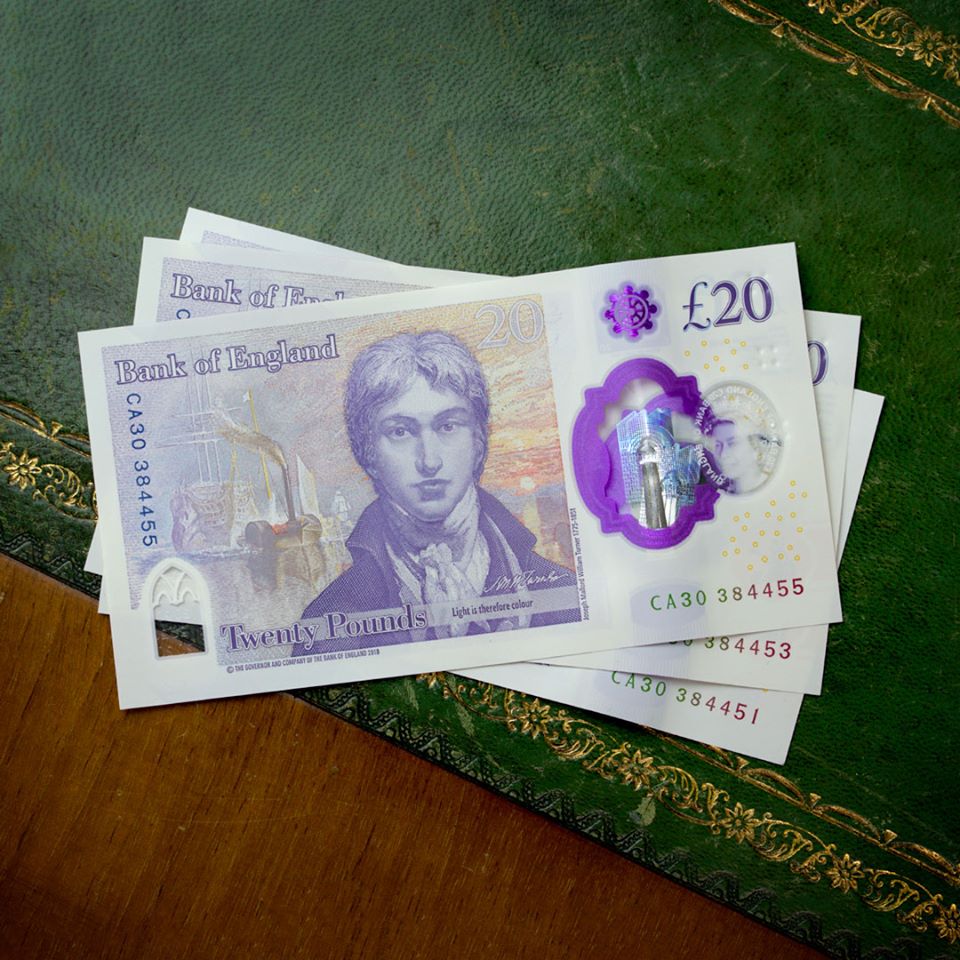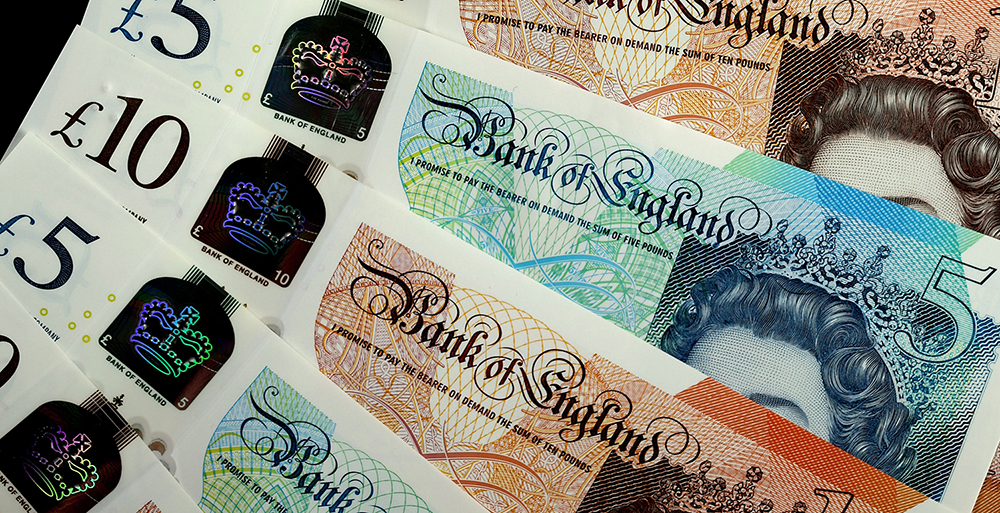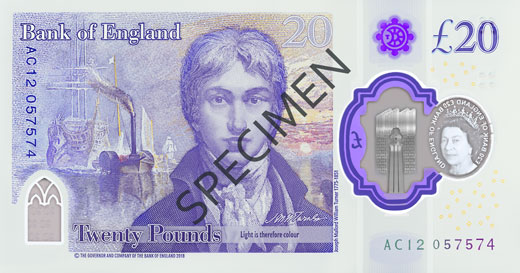Posts Tagged ‘Polymer Banknote’
Which JMW Turner £20 notes should you be looking out for?
The polymer £20 note has been in circulation for over a year now and we’ve certainly been enjoying seeing them being exchanged!

This is the third polymer banknote to be released in the UK, following the release of the polymer Churchill £5 in 2016 and the polymer Jane Austen £10 note in 2017.
Keen collectors have eagerly been hunting down the most sought-after serial numbers for the new note.
When the UK’s first polymer £5 note was released in September 2016, serial numbers became the talk of a nation and stories of early serial numbers selling for thousands of pounds were commonplace.
In fact, an “AK37 007 James Bond Bank of England Polymer £5 note” even sold for £5,000 on eBay – 1,000 times its face value!

But as we await the release of the new note on the 20th of February, which serial numbers should you be looking to get your hands on?
AA01 – the first notes to be printed
AA01 are the first serial numbers to be printed and always prove popular with collectors.
Our eBay Tracker follows the prices of the UK’s Top Coins and Banknotes, including the AA01 polymer £5 and £10 notes, which are currently selling for £10 and £15 respectively. However when the notes were first released we saw a collecting frenzy, with people paying (and demanding) vastly inflated prices for low serial number notes.
Prefixes on the £5 notes started at AA and there are 60 notes on a sheet, AA01- AA60. For each of these cyphers there are 999,000 serial numbers printed: 000001 to 999000. Therefore for the first AA cypher there’s an incredible 59,940,000 notes!
Whilst the £20 note is larger than the £5, meaning less notes will be printed per sheet, there are still A LOT of combinations for AA cyphers on the new £20 – so make sure you keep your eyes out for them!

However, The Bank of England will always hold back some of the notes with the earliest serial numbers, donating them to people or institutions that were involved in the development of the note or who traditionally receive a note when a new series is issued.
For example, the Queen receives AA01 000001 and for the release of the £5 note the Churchill War Rooms received one with serial number AA01 001945, the date that WWII ended.
Key dates to look out for
It’s always worth looking out for certain serial numbers matching key dates relating JMW Turner that could become collectable.
For example, 23 041775 represents Turner’s date of birth, whilst 19 121851 relates to his death and 17 751851 would be his birth and death combined.
True Turner fans might also look for 18 381839 representing the date he painted ‘The Fighting Temeraire’ (featured on the new £20 note) and the date the painting was exhibited at the Royal Academy respectively.

Novelty numbers and Consecutive notes
There may well also be a rush to find the AK47 serial numbers again and James Bond 007 will likely be popular once more.
Consecutively numbered notes are always interesting to collectors too – one man sold three consecutive AA01 notes for £456!
Q&A
Can you request specific serial numbered notes from the bank?
Sadly not. For the launch of the new £5 note 440 million banknotes were printed and these were printed in very large batches.
There will be even more new £20 notes printed than the £5, to service the country’s 48,000 ATMs for example, so it’s just not possible for the bank to separate certain serial numbers.
How much should I pay for a new £20 note?
The simple answer is, it’s completely up to you. An early serial numbered £20 note will be a genuine piece of the country’s history. It’s likely The Bank of England will hold an auction of early editions, so if you have the disposable income, why not?!
Will the old paper £20 note still be legal tender?
You will still be able to use the paper £20 note until The Bank of England withdraw it from circulation. This will be announced after the new note has been issued and they will give six months’ notice of the withdrawal date.
Many banks will accept withdrawn notes as deposits from customers. The Post Office may also accept withdrawn notes as a deposit into any bank account you can access at the Post Office. And, you can always exchange withdrawn notes with The Bank of England directly.
Where will I be able to find the new polymer £20 note?
We will be publishing a list of locations where the polymer £20 note will be available on the 20th, when the new note is released.
With the brand new Alan Turing £50 set to be released on June 23rd, it’s important to refresh your memory on which serial numbers are worth looking out for…
Will you be looking out for any particular serial numbers? Let us know in the comments below!
Own one of the first £1 banknotes issued since decimalisation in 1971 in mint uncirculated condition!
This £1 banknote, which is in mint uncirculated condition, was issued by The Bank of England in 1978-1981. It was part of the Series D Pictorial Issue series of £1 banknotes, and was the first £1 banknote issued since decimalisation in 1971.
Are polymer banknotes indestructible? Millions of damaged notes forced to be replaced…
Do you remember how strange it felt to hold your first polymer £5 note when they were released back in 2016?
Billed as the most durable banknotes yet, the new polymer notes replaced the old paper versions with a thin and flexible plastic material which was said to be cleaner, safer and stronger.
And whilst it’s claimed they should last 2.5 times the lifespan of paper notes, it seems they might not be as durable as once thought…

It’s now been four years since the £5 notes were released, three years since the £10 notes were released and we’re just over a month away from the release of the new polymer £20 note.
Whilst we’re all really excited for the upcoming release of the new £20 note featuring JMW Turner, the question remains as to how durable this note will really be.
50 million damaged polymer banknotes replaced
Recent figures suggest that almost 50 million polymer £5 and £10 notes have been forced to be replaced due to the wear and tear sustained since they were released into circulation.
The Bank of England have said that the damage was mainly caused by “folds, tears, holes and foil wear”.
Figures from the Press Association news agency, say that roughly 20 million polymer £5 notes and around 26 million £10 notes have been swapped so far due to damage.
However, the Bank has never said the new notes are indestructible, instead claiming that they should last 2.5 times longer than paper notes, which were lasting an average of just two years in circulation.
The number of polymer banknotes being replaced only represents a small percentage of the total number which are circulating and the Bank suggests that this is in line with their expectations.

“While we expect the polymer notes to have a longer life, it is too early in the note’s lifecycle to yet understand the rate of replacement of polymer notes,” they said.
“The use of polymer means it can better withstand being repeatedly folded into wallets or scrunched up inside pockets, and can also survive a spin in the washing machine.”
In 2015, 21,835 paper banknotes were replaced due to damage from being torn, washed, contaminated, damaged and even chewed and eaten!
The new polymer material is resistant to dirt and moisture which means they will stay in a better condition for longer.
Plus, when a polymer note reaches the end of its life, it will be recycled, meaning the new notes are more environmentally friendly.
New polymer notes to be released
The new £20 note is due to enter circulation on 20 February 2020 and initially the note will be in circulation alongside the existing paper £20 notes.

These will eventually be phased out as we have seen with the paper £5 and £10 notes in the past years.
We are also expecting the new £50 polymer banknote featuring mathematician and second world war codebreaker Alan Turing in 2021.
Are you looking forward to seeing the new polymer notes, and have you experienced any damage to your £5 and £10 polymer notes? Let us know in the comments below!
If you’re interested in coin collecting, our Change Checker web app is completely free to use and allows users to:
– Find and identify the coins in their pocket
– Collect and track the coins they have
– Swap their spare coins with other Change Checkers

Sign up today at: www.changechecker.org/app
Face of the Fifty Pound Note REVEALED!
This morning The Bank of England revealed Alan Turing as the new face of the £50 banknote, which will be released into circulation in 2021.
In their search to find an eminent British scientist to feature on the £50 note, a total of 227,299 nominations were sent to The Bank of England. 989 eligible characters were narrowed down to a shortlist of just 12 before Turing was finally selected.
Codebreaker Alan Turing will be on Britain’s new 50-pound currency https://t.co/PcmHWkqre3
— TIME (@TIME) July 15, 2019
Other candidates included Rosalind Franklin, Stephen Hawking, Ernest Rutherford and Mary Anning to name a few.
The Bank’s chief cashier, Sarah John said, “The strength of the shortlist is testament to the UK’s incredible scientific contribution. The breadth of individuals and achievements reflects the huge range of nominations we received for this note and I would like to thank the public for all their suggestions of scientists we could celebrate.”

About Alan Turing
Alan Turing is perhaps best known for his outstanding code-breaking which was vital to the Allied victory in WWII.
However, he was also considered a pioneer in computer sciences and the development of the early computer. His work has had an enormous impact on our lives today.
The Bank of England governor, Mark Carney said, “Alan Turing was an outstanding mathematician whose work has had an enormous impact on how we live today. As the father of computer science and artificial intelligence, as well as [a] war hero, Alan Turing’s contributions were far ranging and path breaking. Turing is a giant on whose shoulders so many now stand.”
Sadly, in 1952 he was prosecuted for homosexual acts and died in 1954 from cyanide poisoning. It was determined that his death was an act of suicide.
The new note
Next year the new £20 polymer note will be issued, featuring British Artist, JMW Turner.
This will be the third UK banknote to be made from polymer and will be swiftly followed by the new £50 note in 2021, thus completing the UK’s changeover to plastic banknotes.
These notes are more durable, secure and environmentally friendly than paper notes.

The future of cash
There have been debates in recent years as to whether or not Britain should become a cashless society.
The rise of card and electronic payments means that many see cash as becoming obsolete, with the 1p and 2p coins at the heart of the debate.
In addition to this, the validity of the £50 note has also been questioned, as it is rarely used in everyday payments and is widely thought of as being used by criminals.
The good news for Change Checkers is that the Treasury have confirmed that cash will be around for years to come.
And, with the introduction of the new Alan Turing £50 note in 2021, I think it’s fair to say that cash is still king.
If you’re interested in coin collecting, our Change Checker web app is completely free to use and allows users to:
– Find and identify the coins in their pocket
– Collect and track the coins they have
– Swap their spare coins with other Change Checkers
Sign up today at: www.changechecker.org/app





